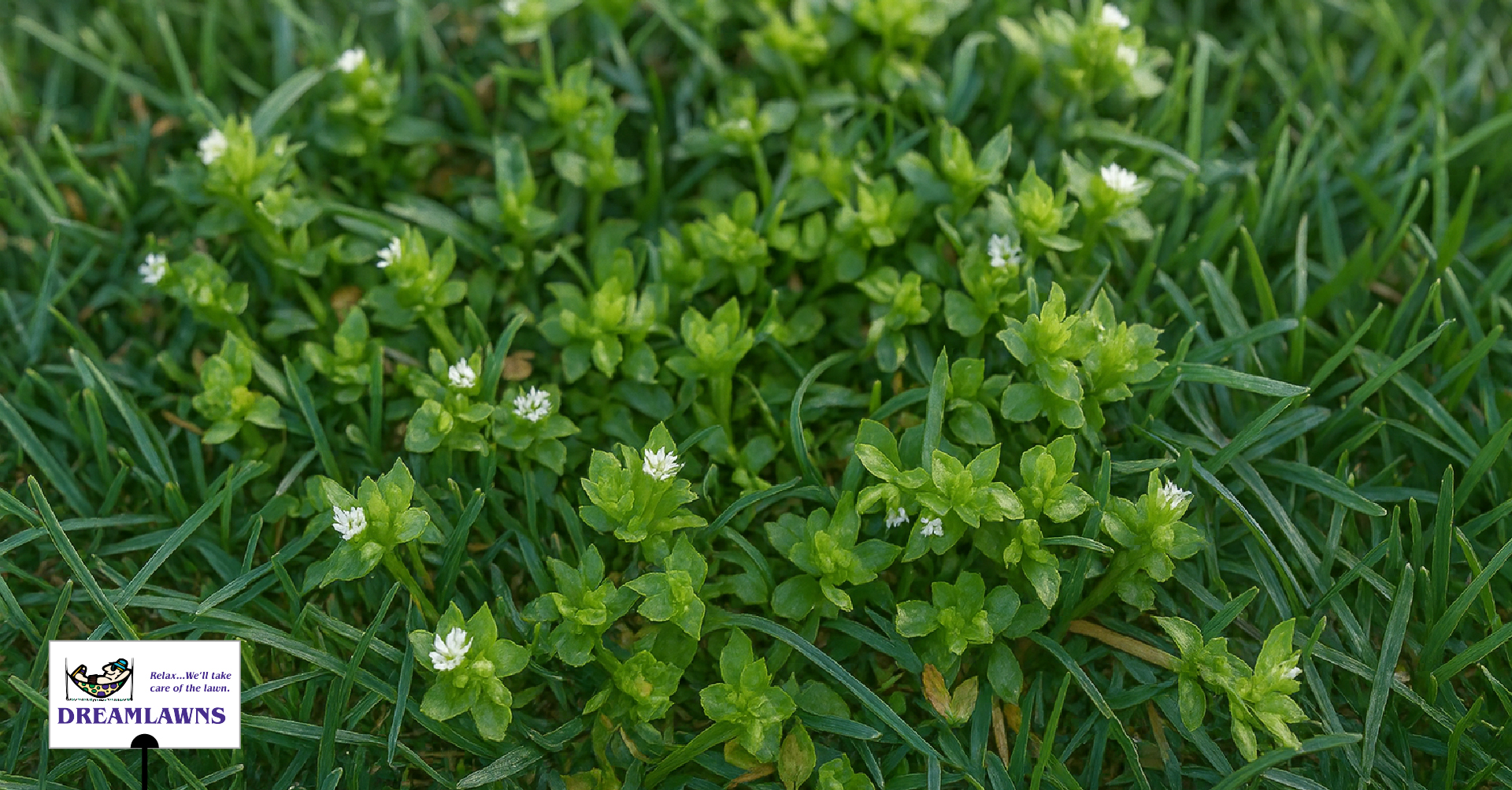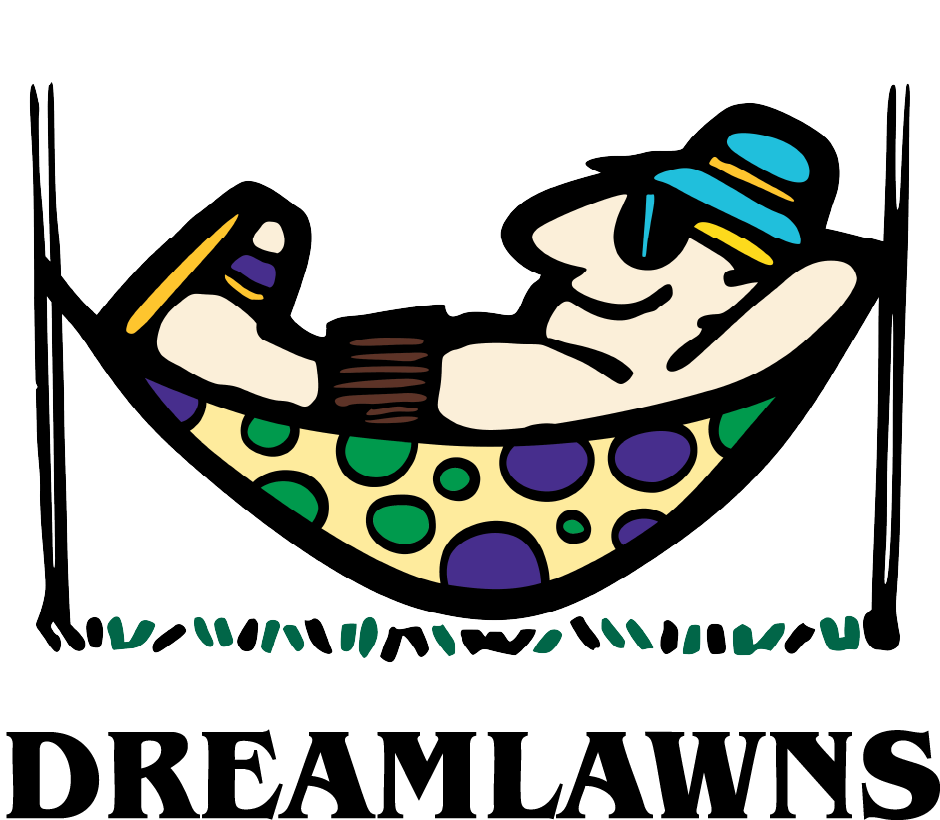
Dreamlawns Quick Cut: Fall is when winter weeds like henbit, chickweed, and annual bluegrass germinate in Virginia Beach lawns. By spring, they’re already established and competing with turf for nutrients. The only way to stop them is with properly timed pre-emergent applications in October – November. Waiting until spring is too late. Dreamlawns provides expert lawn weed control and complete weed control services near me to keep your lawn healthy and weed-free year-round.
When most homeowners think about weeds, they picture crabgrass spreading through their lawn in the summer heat. But weed season doesn’t end when the temperatures drop, in fact, fall is when some of the most persistent weeds in Virginia Beach first begin to take root. Henbit, chickweed, and annual bluegrass all germinate in October and November. While they may not be noticeable right away, these weeds quietly grow through the cooler months, then explode in spring, stealing nutrients and sunlight from your turf when it needs strength the most.
The only way to stop these weeds before they take over is with properly timed pre-emergent applications. Applying too late, or skipping fall weed control altogether, means your lawn enters spring already at a disadvantage.
Let’s explore which weeds germinate in fall, what pre-emergent actually is, why timing is critical, and how Dreamlawns provides the professional solutions your lawn needs to stay weed-free year-round.
What Weeds Germinate in Fall?
Spring and summer may be the peak season for crabgrass and broadleaf weeds, but fall brings a different set of invaders. These weeds thrive in the cooler weather of October and November, when many homeowners mistakenly believe their lawn is “safe” from new growth. The most common fall-germinating weeds in Virginia Beach include:
- Henbit: Henbit is a winter annual weed with square stems and purple flowers that spreads quickly in thin turf.
- Chickweed: Chickweed is a low-growing weed that forms dense mats, smothering healthy grass and stealing nutrients.
- Annual Bluegrass (Poa annua): Poa annua is one of the toughest lawn weeds to manage. It germinates in the fall, overwinters, and produces unsightly seed heads in spring.
These weeds germinate when soil temperatures drop in autumn, then quietly establish roots through winter. By the time spring arrives, they’re already strong enough to outcompete turfgrass, making them much harder to control. That’s why prevention in the fall is so critical. The right pre-emergent application keeps these weeds from sprouting in the first place.
What Is Pre-Emergent?
Pre-emergent herbicides are one of the most important tools in effective lawn weed control. Unlike post-emergent products, which target weeds after they’ve already sprouted, pre-emergents work by creating a protective barrier in the soil that prevents weed seeds from germinating. You can think of pre-emergent as a weed preventer, and post-emergent as a weed killer.
Key points about pre-emergents:
- They don’t kill existing weeds. Pre-emergents stop new weeds from sprouting, but won’t eliminate weeds that are already established.
- They act as a barrier. Once applied and watered in, pre-emergent herbicides coat the soil’s surface, preventing weed seedlings from breaking through.
- Timing is everything. Pre-emergents must be applied before weed seeds germinate. Applying them after the weeds are visible is too late.
For fall in Virginia Beach, pre-emergents are especially critical against weeds like henbit, chickweed, and annual bluegrass. These weeds start germinating in October – November, so a properly timed application is the only way to stop them before they become a springtime headache.
Why Pre-Emergent Timing Matters
When it comes to pre-emergent timing, the rule is simple: apply it before weed seeds germinate. For Virginia Beach, that means targeting the window of October through early November. Wait too long, and winter weeds like henbit, chickweed, and annual bluegrass will already be established under the surface, ready to spread come spring.
Key reasons timing is so critical:
- Weeds germinate earlier than most people think. By the time you notice them, they’ve already developed roots.
- Pre-emergents lose effectiveness if applied too late. They can only prevent germination, not kill existing weeds.
- One missed season can result in a full year of weed pressure. Fall weeds that take hold will compete with your turf all winter and spring.
Can Pre-Emergents Be Applied with Fall Fertilizers?
Yes, in many cases, pre-emergents can be applied around the same time as fall fertilizers, but they serve different purposes and require careful scheduling.
- Pre-emergent first: The herbicide needs to be applied before weed seeds sprout and watered in to activate.
- Fertilizer next: Fall fertilizers, especially those high in nitrogen, which are crucial for a healthy lawn, are typically applied later in the season to promote strong root growth for turf recovery and winter hardiness.
- Professional programs combine the two strategically: At Dreamlawns, we provide a year-round lawn care program that includes pre-emergent applications and fertilization schedules so that your lawn gets both weed prevention and the nutrients it needs, without overlap that reduces effectiveness.
Common Mistakes Homeowners Make with Fall Weed Control
Even when homeowners know weeds can sprout in the fall, it’s easy to miss the mark on control. Missteps in timing, product choice, or strategy often leave lawns vulnerable to winter annual weeds. The most common mistakes include:
- Applying pre-emergent too late: Once weeds germinate, the barrier is useless. At that point, only post-emergent treatments will work.
- Using the wrong product or rate: Not all pre-emergents are the same, and applying too little or too much reduces effectiveness or risks harming turf.
- Assuming overseeding replaces weed prevention: Overseeding builds density, but it doesn’t stop weeds from germinating. Pre-emergents and seeding should be managed together, not treated as interchangeable.
- Forgetting different weeds germinate at different times: Chickweed, henbit, and annual bluegrass don’t follow the same schedule. Skipping fall applications gives them a head start.
- Not watering in the pre-emergent: Most products require irrigation to move into the soil and form the barrier that prevents germination.
Avoiding these mistakes is the difference between a lawn that enters spring full of weeds and one that’s ready to thrive.
How Fall Weeds Impact Your Lawn Long-Term
It’s tempting to ignore a few weeds in the fall, but the damage they cause can extend well beyond the cooler months. Winter annual weeds may look small and harmless now, but they quietly compete with turfgrass for the same resources your lawn needs to stay healthy. Long-term effects of fall weeds include:
- Thinning Turf: Weeds crowd out grass, leaving lawns patchy and weak heading into spring.
- Nutrient Competition: Weeds steal water and nutrients that should be fueling turf recovery and root development.
- Weaker Resistance to Stress: Grass under weed pressure is more susceptible to disease and pest activity.
- Poor Spring Appearance: By the time warm weather returns, weeds are often stronger than the turf, creating an unattractive lawn that’s harder to restore.
- Increased Costs Later: Skipping fall weed prevention usually means heavier post-emergent treatments and repair work in spring.
This is why lawn weed control is more than just a cosmetic choice. Preventing fall weeds with pre-emergent applications keeps your lawn dense, healthy, and better able to resist stress year-round.
Professional Solutions from Dreamlawns
Weeds are complicated, and you’ve probably noticed there’s no shortage of products and advice out there. The challenge isn’t just applying something, it’s knowing what to apply, when to apply it, and how to combine it with the rest of your lawn care routine. That’s where Dreamlawns makes the difference. Here’s how our professional weed control services set your lawn up for success:
- Science-Based Pre-Emergent Applications: We apply pre-emergents at the right time in the fall to block weeds like henbit, chickweed, and annual bluegrass before they ever break through the soil.
- Integrated Seasonal Services: Weed control isn’t a one-off treatment. Our applications are timed to work alongside aeration, overseeding, and fertilization so your turf grows stronger and naturally resists future weed invasions.
- Year-Round Protection: Fall is only one part of the weed lifecycle. With our full-service programs, you get continuous prevention and post-emergent treatments, ensuring your lawn stays weed-free across every season.
- Local Expertise: Virginia Beach lawns face unique challenges due to sandy soils, humidity, and mild winters that encourage weed growth. Our team has the experience to anticipate these issues and tailor solutions to your yard.
By combining prevention, timing, and tailored treatment plans, Dreamlawns delivers more than just weed control, we deliver peace of mind that your lawn will stay healthy and attractive year-round.
Stop Fall Weeds Before They Take Over
Fall weeds may not look like much when they first appear, but once they germinate, they’re already competing with your turf and setting the stage for spring problems. The key is prevention, and that comes down to getting pre-emergent timing right. Apply too late, and you’ll spend next season fighting weeds that could have been stopped months earlier.
At Dreamlawns, we specialize in proactive solutions that keep weeds out of your lawn before they become a problem. From pre-emergent applications to full lawn weed control programs, our team delivers the expertise and timing your lawn needs to stay healthy and weed-free.
Don’t wait until spring to take action. Contact us today to schedule your fall weed control service and protect your lawn before winter annuals take root.
Dreamlawns provides superior lawn care service to Virginia Beach & Chesapeake VA residents.




